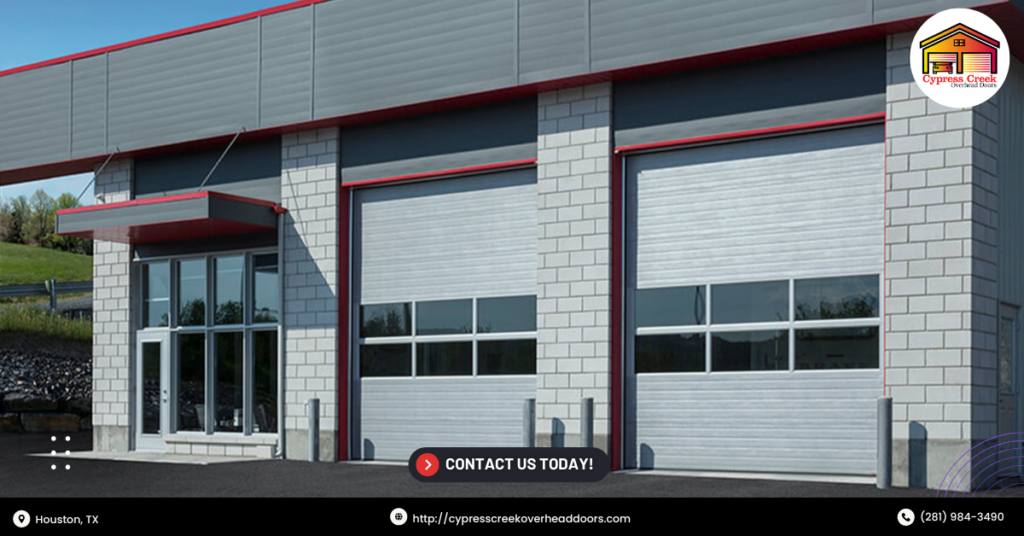
Discover how Cypress Creek Overhead Doors simplifies commercial garage door installation in Houston, TX. Learn step-by-step tips, safety considerations, and customization options for your business.
Installing a commercial garage door isn’t just a functional necessity; it’s an investment in your business’s security, efficiency, and curb appeal. Whether you’re in a bustling downtown area or an expansive industrial park in Houston, TX, having the right garage door can make a significant difference in your day-to-day operations. At Cypress Creek Overhead Doors, we understand the unique needs of businesses in Houston, and we’re here to guide you through every step of the installation process. In this comprehensive guide, we’ll cover everything from choosing the right door to troubleshooting common issues, and ensuring your commercial garage door installation goes off without a hitch.
Why Installing Commercial Garage Doors in Houston Matters
Houston is a vibrant, bustling city with a diverse range of businesses, from retail stores to warehouses. Each of these businesses relies on efficient, secure, and durable commercial garage doors to keep operations running smoothly. Proper installation of these doors is crucial for a few reasons:
- Security: A well-installed garage door protects your assets, employees, and customers.
- Efficiency: Smooth operation reduces downtime and keeps your business running efficiently.
- Curb Appeal: A stylish and well-maintained garage door enhances your business’s appearance, making a positive impression on clients and customers.
The Benefits of Proper Installation for Businesses
Investing in a high-quality garage door and ensuring it’s correctly installed can save you numerous headaches down the line. Proper installation means fewer repairs, better security, and smoother operation. Let’s break down these benefits further:
- Fewer Repairs: Correct installation minimizes the likelihood of operational issues and breakdowns, saving you money on repairs.
- Better Security: A securely installed door prevents unauthorized access, protecting your inventory and equipment.
- Smoother Operation: A well-installed door operates seamlessly, reducing wear and tear on components and extending the door’s lifespan.
- Enhanced Appearance: An attractive garage door boosts your business’s curb appeal, which is particularly important in areas where customer traffic is high.
Choosing the Right Commercial Garage Door
Selecting the right garage door for your business involves several considerations. Here’s what you need to think about:
Types of Commercial Garage Doors
Commercial garage doors come in various styles, each suited to different needs:
- Roll-Up Doors: Ideal for saving space, as they roll up into a coil above the opening.
- Sectional Doors: Made up of panel sections connected with hinges, offering excellent insulation and security.
- Sliding Doors: Slide open to the side, great for larger openings.
- Fire-Rated Doors: Provide additional fire protection, essential for certain types of businesses.
Material Options: Steel, Aluminum, and More
The material of your garage door impacts its durability, maintenance, and appearance:
- Steel Doors: Extremely durable and offer great security, but can be prone to rust if not properly maintained.
- Aluminum Doors: Lightweight and resistant to rust, making them suitable for humid environments.
- Wood Doors: Offer a classic look but require more maintenance to prevent warping and decay.
- Fiberglass Doors: Resistant to dents and rust, but not as strong as steel or aluminum.
Insulated vs. Non-Insulated Doors: What’s Best for Your Business?
In Houston’s hot climate, insulated doors can help regulate temperatures inside your facility, saving on energy costs. However, if temperature control isn’t a priority, non-insulated doors can be a cost-effective option. Consider factors like your building’s temperature needs, energy efficiency goals, and budget when making this decision.
Preparing for Installation
Measuring Your Space: Getting Accurate Dimensions
Accurate measurements are crucial for a smooth installation. Measure the width, height, and depth of the garage opening to ensure the door fits perfectly. Here are some tips for measuring correctly:
- Measure the width and height of the opening at multiple points to account for any irregularities.
- Measure the space above the opening (headroom) and the sides (side room) to ensure there’s enough clearance for the door and tracks.
- Note any obstructions, such as pipes or light fixtures, that could interfere with the door’s operation.
Assessing Structural Requirements and Local Building Codes
Ensure your building can support the weight and structure of a new garage door. Check local building codes to comply with regulations and avoid any legal issues. Here’s what you need to consider:
- Structural Integrity: The walls and ceiling must be strong enough to support the door’s weight and the force exerted by the springs and opener.
- Building Codes: Local codes may dictate specific requirements for commercial garage doors, such as wind resistance or fire ratings. Check with your local building department to ensure compliance.
Gathering Necessary Tools and Materials
Having the right tools on hand will make the installation process smoother. Basic tools include a level, drill, wrenches, and safety gear. Here’s a more detailed list:
- Tools: Tape measure, level, drill, socket wrench set, pliers, screwdrivers, ladder, and safety glasses.
- Materials: New garage door kit (including tracks, panels, springs, and hardware), mounting brackets, and any additional components required for your specific installation.
Step-by-Step Installation Process
Removing the Old Door (If Applicable)
If you’re replacing an existing door, safely remove it without damaging the structure. Here’s how:
- Disconnect the Opener: If your door has an opener, disconnect it to prevent accidental operation.
- Remove the Springs: Carefully release the tension on the springs to avoid injury. This step can be dangerous, so proceed with caution or seek professional help.
- Dismantle the Panels: Remove the door panels one by one, starting from the top.
Installing the Tracks and Rollers
Start by assembling the tracks and attaching them to the garage walls. Ensure they are level to avoid operational issues later on. Here’s the process:
- Attach the Vertical Tracks: Secure the vertical tracks to the wall using brackets and screws.
- Install the Horizontal Tracks: Connect the horizontal tracks to the vertical tracks and secure them to the ceiling.
- Add the Rollers: Insert rollers into the door panels and place them into the tracks.
Assembling the Door Panels
Assemble the door panels on the floor before installing them. This step ensures they fit together correctly and operate smoothly. Here’s how:
- Lay Out the Panels: Arrange the panels in the correct order on the floor.
- Attach Hinges: Connect the hinges to the panels according to the manufacturer’s instructions.
- Install Weatherstripping: If your door includes weatherstripping, attach it to the bottom panel.
Securing the Hinges and Brackets
Attach the hinges and brackets to the door panels. These components are crucial for the door’s stability and operation. Here’s what to do:
- Hinges: Secure the hinges between the panels, ensuring they are tightly fastened.
- Brackets: Attach the brackets to the bottom and top panels. These will hold the rollers in place and connect to the tracks.
Installing the Springs and Cables
This step can be tricky and potentially dangerous. Garage door springs hold a lot of tension, so it’s often best to call a professional for this part. Here’s an overview:
- Torsion Springs: Attach the torsion springs to the header above the door. Wind the springs to the correct tension according to the manufacturer’s instructions.
- Extension Springs: If your door uses extension springs, attach them to the tracks and connect the cables to the bottom brackets.
Adding the Garage Door Opener
Once the door is in place, install the garage door opener. Follow the manufacturer’s instructions to ensure it’s correctly set up and functioning. Here’s a brief outline:
- Mount the Opener: Secure the opener to the ceiling, ensuring it’s aligned with the center of the door.
- Attach the Rail: Connect the rail to the opener and attach it to the header bracket above the door.
- Connect the Arm: Attach the opener arm to the door and connect it to the rail.
Safety Considerations
Handling Heavy Components Safely
Garage doors and their components are heavy. Use proper lifting techniques and consider having a helper to avoid injury. Here are some tips:
- Lift with Your Legs: Bend at the knees, not the waist, to lift heavy components.
- Use a Partner: Having someone to help you can make lifting and positioning parts easier and safer.
- Wear Safety Gear: Always wear safety glasses and gloves to protect yourself from sharp edges and debris.
Importance of Professional Installation for Certain Steps
While many steps can be DIY, some, like spring installation, are best left to professionals to ensure safety and proper functioning. Here’s why:
- Tension Springs: These springs are under high tension and can cause serious injury if mishandled. A professional has the tools and expertise to handle them safely.
- Complex Systems: Some commercial doors have complex components and systems that require specialized knowledge to install correctly.
Regular Maintenance Tips to Ensure Safety
Regular maintenance is key to keeping your door operating smoothly. Here are some tips:
- Lubricate Moving Parts: Apply a garage door lubricant to the rollers, hinges, and springs to reduce friction and wear.
- Inspect Cables and Springs: Check for signs of wear or damage and replace any components that show signs of weakness.
- Test Door Balance: Disconnect the opener and manually lift the door halfway. If it stays in place, it’s balanced. If not, adjust the springs.
Customizing Your Commercial Garage Door
Adding Windows and Decorative Hardware
Custom windows and hardware can enhance the appearance of your door and complement your building’s architecture. Here are some options:
- Windows: Add windows to the top or middle panels to let in natural light and improve aesthetics.
- Decorative Hardware: Choose from a variety of handles, hinges, and accents to give your door a unique look.
Choosing the Right Color and Finish
Select a color and finish that aligns with your business’s branding and aesthetic. Durable finishes can also protect your door from the elements. Here’s how to decide:
- Match Your Brand: Choose colors that complement your business’s logo and branding.
- Consider Durability: Opt for finishes that can withstand Houston’s weather, such as powder-coated or baked-on enamel finishes.
Integrating Security Features and Access Controls
Consider adding advanced security features like keyless entry, motion sensors, and security cameras to enhance safety. Here’s what to consider:
- Keyless Entry: Install a keypad or smartphone-controlled entry system for easy and secure access.
- Motion Sensors: Add sensors to detect movement and alert you to potential intruders.
- Security Cameras: Install cameras to monitor the area around your garage door for added security.
Troubleshooting Common Installation Issues
Misaligned Tracks and How to Fix Them
Misaligned tracks can cause operational issues. Here’s how to fix them:
- Check Alignment: Use a level to ensure the tracks are parallel and aligned correctly.
- Adjust Brackets: Loosen the mounting brackets and adjust the tracks until they are straight. Tighten the brackets to secure the tracks in place.
Dealing with Unbalanced Doors
An unbalanced door can be dangerous. Here’s how to check and adjust the balance:
- Test Balance: Disconnect the opener and manually lift the door halfway. If it doesn’t stay in place, it needs adjustment.
- Adjust Springs: Increase or decrease the tension on the springs to balance the door. This step is best done by a professional due to the high tension involved.
Addressing Opener Malfunctions
If the opener isn’t working correctly, here’s what to check:
- Power Source: Ensure the opener is plugged in and the circuit breaker hasn’t tripped.
- Remote Batteries: Replace the batteries in the remote control.
- Alignment: Check that the sensors are aligned and not obstructed.
Maintaining Your Commercial Garage Door
Regular Inspection Checklist
Create a checklist for regular inspections. Here’s what to include:
- Visual Inspection: Check for signs of wear, rust, and damage on all components.
- Test Operation: Open and close the door to ensure it operates smoothly and without unusual noises.
- Check Balance: Test the door’s balance and adjust as needed.
Lubrication and Cleaning Tips
Lubricate moving parts and clean the door regularly to keep it in top condition. Here’s how:
- Lubricate Parts: Apply lubricant to the rollers, hinges, springs, and tracks every six months.
- Clean the Door: Use mild soap and water to clean the door panels, avoiding harsh chemicals that can damage the finish.
When to Call a Professional for Repairs
Some issues require professional attention. Here’s when to call for help:
- Persistent Problems: Contact a professional if you notice recurring issues you can’t fix.
- Safety Concerns: Any concerns involving springs, cables, or structural components should be addressed by a professional.
Conclusion
Installing a commercial garage door in Houston, TX, might seem daunting, but with the right preparation and understanding, it can be a smooth process. At Cypress Creek Overhead Doors, we’re here to help every step of the way. From garage door spring repair to emergency garage door repair, we’ve got you covered. Houston is a vibrant city with landmarks like the Space Center, the Museum District, and bustling business hubs. Your business deserves a garage door that functions seamlessly and adds to the aesthetic of our beautiful city. Ready to take the next step? Contact us today for all your commercial garage door needs.
Are you ready to upgrade your commercial garage doors? Schedule a consultation with Cypress Creek Overhead Doors today! Explore our range of commercial garage door options and learn more about our installation services. Let’s get your business running smoothly with the best garage doors in Houston, TX.
FAQs
Q: How long does the installation process take? A: Typically, a commercial garage door installation can take a few hours to a full day, depending on the complexity and size of the door.
Q: Can I install a commercial garage door myself? A: While some steps can be DIY, we highly recommend professional installation, especially for parts involving springs and cables due to the high tension and potential danger.
Q: How often should I schedule maintenance for my commercial garage door? A: Regular maintenance should be done annually, but it’s good to inspect and lubricate parts every few months to ensure optimal performance.
Have you ever faced issues with your commercial garage door that disrupted your business operations? Share your experience in the comments below!

